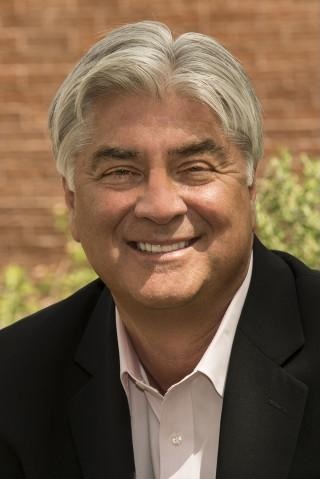A breakfast meeting of the Arizona Thoracic Society and the Tucson winter lung series was held on Saturday, 12/14/2013 at Kiewit Auditorium on the University of Arizona Medical Center Campus beginning at 8:30 AM. There were 31 in attendance.
A lecture was presented by Joe G. N. "Skip" Garcia, MD, the senior vice president for health sciences at the University of Arizona (Figure 1).

Figure 1. Joe G. N. “Skip” Garcia, MD
The title of Garcia’s talk was “Personalizing Medicine in Cardiopulmonary Disorders: The Post ACA Landscape”.
Garcia began with reiterating that the Affordable Care Act (ACA, Obamacare) is fact and could pose a threat to academic medical centers. However, he views the ACA as an opportunity to develop personalized medicine which grew from the human genome project. Examples cited included the genetic variability among patients in determining the dose of warfarin and bronchodilator response to beta agonists in asthma (1,2).
Garcia’s laboratory has studied predominately 6 diseases including the adult respiratory distress syndrome (ARDS), idiopathic pulmonary fibrosis (IPF), sarcoidosis, asthma, pulmonary artery hypertension and sickle cell disease. Each has in common that there has been minimal progress made in the past generation and each has been shown to have racial or ethnic disparities in outcomes. He cited examples of how molecular testing could improve care.
Black and Hispanic patients with ARDS have a significantly higher risk of death compared with white patients (3). Garcia noted that the ventilator is not necessarily a friend and use of higher tidal volumes has been associated with increased mortality (4). He reasoned that the variation in susceptibility to ventilator induced lung injury could potentially explain the racial differences in mortality. Beginning with a dog model of ARDS, highly significant regional differences in gene expression were observed between lung apex/base regions. One of these potential targets was pre-B-cell colony enhancing factor (PBEF), a gene not previously associated with lung pathophysiology (5). Further work showed PBEF could induce changes seen in ARDS including a neutrophil alveolitis and increases in nuclear factor-κβ (NFKB) expression (6).
Few would question that there is a need for validated biomarkers in idiopathic pulmonary fibrosis. Using a similar approach to the investigation of PBEF in ARDS, peripheral blood mononuclear cell (PBMC) gene expression profiles predictive of poor outcomes in idiopathic pulmonary fibrosis (IPF) were examined by microarray. Microarray analyses suggest that 4 genes (CD28, ICOS, LCK, and ITK) are potential outcome biomarkers in IPF and should be further evaluated for patient prioritization for lung transplantation and stratification in drug studies (7). PBMC gene expression profiles were also examined in sarcoidosis. There was a significant association of single nucleotide polymorphisms (SNPs) in signature genes with sarcoidosis susceptibility and severity (8). Further examples were presented on sickle cell disease.
Garcia concluded that molecular techniques represent powerful tools to investigate potential therapeutic approaches in respiratory diseases where little progress has been made.
Richard A. Robbins, MD
References
- International Warfarin Pharmacogenetics Consortium, Klein TE, Altman RB, Eriksson N, Gage BF, Kimmel SE, Lee MT, Limdi NA, Page D, Roden DM, Wagner MJ, Caldwell MD, Johnson JA. Estimation of the warfarin dose with clinical and pharmacogenetic data. N Engl J Med. 2009;360(8):753-64. [CrossRef] [PubMed]
- Duan QL, Lasky-Su J, Himes BE, Qiu W, Litonjua AA, Damask A, Lazarus R, Klanderman B, Irvin CG, Peters SP, Hanrahan JP, Lima JJ, Martinez FD, Mauger D, Chinchilli VM, Soto-Quiros M, Avila L, Celedón JC, Lange C, Weiss ST, Tantisira KG. A genome-wide association study of bronchodilator response in asthmatics. Pharmacogenomics J. 2013 Mar 19. [Epub ahead of print] [CrossRef] [PubMed]
- Erickson SE, Shlipak MG, Martin GS, Wheeler AP, Ancukiewicz M, Matthay MA, Eisner MD; National Institutes of Health National Heart, Lung, and Blood Institute Acute Respiratory Distress Syndrome Network. Racial and ethnic disparities in mortality from acute lung injury. Crit Care Med. 2009 Jan;37(1):1-6. [CrossRef] [PubMed]
- The Acute Respiratory Distress Syndrome Network. Ventilation with lower tidal volumes as compared with traditional tidal volumes for acute lung injury and the acute respiratory distress syndrome. N Engl J Med. 2000;342(18):1301-8. [CrossRef] [PubMed]
- Simon BA, Easley RB, Grigoryev DN, Ma SF, Ye SQ, Lavoie T, Tuder RM, Garcia JG. Microarray analysis of regional cellular responses to local mechanical stress in acute lung injury. Am J Physiol Lung Cell Mol Physiol. 2006;291(5):L851-61. Herazo-Maya JD, Noth I, Duncan SR, Kim S, Ma SF, Tseng GC, Feingold E, Juan-Guardela BM, Richards TJ, Lussier Y, Huang Y, Vij R, Lindell KO, Xue J, Gibson KF, Shapiro SD, Garcia JG, Kaminski N. Peripheral blood mononuclear cell gene expression profiles predict poor outcome in idiopathic pulmonary fibrosis. Sci Transl Med. 2013 Oct 2;5(205):205ra136.
- Hong SB, Huang Y, Moreno-Vinasco L, Sammani S, Moitra J, Barnard JW, Ma SF, Mirzapoiazova T, Evenoski C, Reeves RR, Chiang ET, Lang GD, Husain AN, Dudek SM, Jacobson JR, Ye SQ, Lussier YA, Garcia JG. Essential role of pre-B-cell colony enhancing factor in ventilator-induced lung injury. Am J Respir Crit Care Med. 2008;178(6):605-17. [CrossRef] [PubMed]
- Zhou T, Zhang W, Sweiss NJ, Chen ES, Moller DR, Knox KS, Ma SF, Wade MS, Noth I, Machado RF, Garcia JG. Peripheral blood gene expression as a novel genomic biomarker in complicated sarcoidosis. PLoS One. 2012;7(9):e44818. [CrossRef] [PubMed]
Reference as: Robbins RA. December 2013 Arizona thoracic society notes. Southwest J Pulm Crit Care. 2013;7(6):360-2. doi: http://dx.doi.org/10.13175/swjpcc175-13 PDF
 Saturday, January 31, 2015 at 8:00AM
Saturday, January 31, 2015 at 8:00AM 
